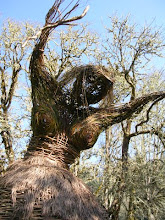Now and then I am confronted by someone who does not understand how I can participate in activity that involves “destroying books.” But yes – I do, and without qualms.
Georgia O'Keefe homage, for "Divine Women" altered book
I explain to them that hundreds of thousands of unwanted books are shredded or sent to the landfill every year. It’s hard to swallow, if you love books, but not every printed volume is precious. Book alterers try to “repurpose” these unwanted books into works of art. Others use old books to create shelves, accessories such as handbags, even furniture.
"Henge" foldout for Spiritual Places altered book
Some of us just enjoy creating art in them. That can involve carving niches, gluing things into them, painting pages, and whatever creative approaches one can devise.
Others created by carving. I can’t imagine the patience it takes for Su Blackwell to do what she does, but the results are fantastically beautiful. Su Blackwell's fabulous book sculptures.
Brian Dettmer is no less amazing with his “revealed” image carving.
Brian Dettmer's intriguing book carvings.
And no, I don’t even try to emulate these artists. I just have fun with a group of local friends who participate in round robins. Each member starts a book on a theme, and then the books are passed from member to member so that each can created in each book. At the end the books wind up back with the person who started them, but now stuffed with the artwork of other members.
"I Killed the Bird" for Literary Cats altered book
Well, what are they good for? people then ask. What is any artwork good for? To enjoy – to look at again and again – to share with visitors (many of whom become so intrigued that they want to participate). Each book becomes a virtual art gallery. Since the members of each round robin tend to change from one session to another (each person has three to four weeks to complete a minimum number of pages, the length of time and number of pages depending on the number of participating members) there are always new approaches and styles. There are usually 8-12 participants, so one round robin per year is about the limit for most of us. Other groups participate by mail, or they exchange pages to be inserted in the books.
In respect of the rights of my fellow artists, I won’t post examples of their work, but herein I have offered a few of my own.
Copper embossed frog for "Frog" altered book


.jpg)





